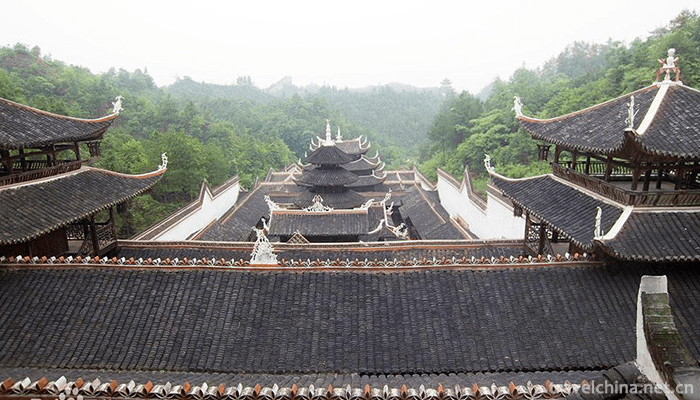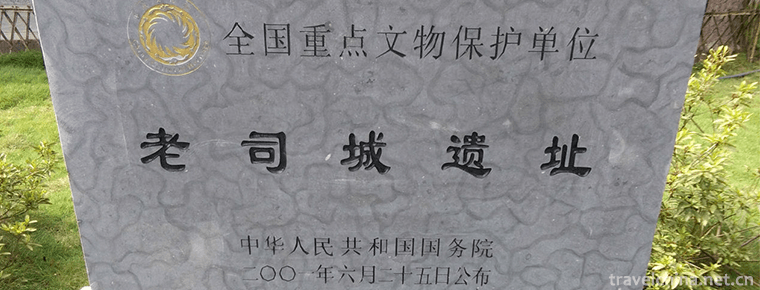Yongshun Tusi City Site
Yongshun Tusi City Site
Laosicheng Site in Yongshun, Hunan Province, is located in Laosicheng Village, Lingxi Town, more than 20 kilometers east of Yongshun County, Tujia and Miao Autonomous Prefecture, western Hunan Province. The original name of Fushicheng is the ancient capital ruled by the Tusi Dynasty for 800 years. It is also called Sicheng and Laosicheng. It was the political, economic, military and cultural center of Peng Chieftain of Yongshun from Shaoxing in the Southern Song Dynasty (1135) to Yongzheng in the Qing Dynasty (1724).
Laoshi City is divided into Nero City and Wailuo City, with eight streets and ten lanes crisscrossing, densely populated and prosperous shops. Historical books include "3000 households in the city, 800 households outside the city", "the huge town of five streams, the border city of ten thousand miles".
Laosicheng is the materialized carrier of the Chieftain System and a living specimen of the development of the regional ethnic autonomy system in ancient China. It was announced as the fifth batch of national key cultural relics protection units in 2001. In September 2010, Laosicheng Site was listed in the list of the first national archaeological sites parks in China. On July 04, 2015, the "Chinese Chieftain Heritage" jointly represented by Yongshun Laosicheng Site, Tangya Tusi City Site in Enshi, Hubei Province and Hailongtun Tusi Site in Zunyi, Guizhou Province was listed on the World Cultural Heritage List.
Historical evolution
In the fourth year of Liang Kaiping (910 A.D.) after the Five Dynasties, Ma Yin, king of Chu, accepted Peng's entry into Southern Chu, and let Peng's serve as the assassin of Xizhou. Peng's kindness in Xizhou united the hearts of the people. He was welcomed by the people of Xizhou and became the hereditary chieftain of Xizhou.
In the fifth year of Shaoxing in the Southern Song Dynasty (1135), Peng Fushichong (Peng Fushichong) served as Chieftain. He often felt that Chief Executive (Chieftain's Office) was bound by Chenzhou forces in Xiaxhou, so he moved Chief Executive to Fushi County in Lingxi and built a city here, that is, Laosheng.
In the Yuan Dynasty, the original Xizhou was divided into Yongshun Anfu, Geman Anfu (under the jurisdiction of South Weizhou), and Sizhou Anfu (under the jurisdiction of Maizhe, Huixi, Shi Rong, Jidong and La Yao Dong). Peng Chieftain of Yongshun actually has limited space.
In the Ming Dynasty, Yongshun Tusi rebuilt Laosheng. Most of the existing buildings at the site were built in the Ming Dynasty.
In the second year of Yongzheng (1724), Peng Zhaohuai, the Tusi of Yongshun, moved Shizhi to Kesha Township in the upper reaches of Lingxi River, which is called Xinsi City. In 1728, Peng Zhaohuai, the Tusi of Yongshun, voluntarily offered his soil and took his descendants away from Hunan and Xiangxi, and returned to Jiangxi to establish a family. The regime of the Tusi of Yongshun, which lasted for 818 years, came to an end. Since then, Laoshi City has gradually become cold and depressed.
From 1995 to 2012, Hunan Institute of Cultural Relics and Archaeology, together with the Cultural Relics Task Force of Xiangxi Autonomous Prefecture and the Cultural Relics Bureau of Yongshun County, conducted five times of archaeological investigation, exploration and excavation of Laosicheng and its surrounding sites.
In 2010, Yongshun County Government launched the project of "Laoshi City Conservation and Utilization Project", which is expected to be completed in 2015. It plans to build the Laoshi City site into a national archaeological site park and a cultural and ecological tourism destination.
Protection of cultural relics
In October 1983, the ancestral temple and the ancient tomb group of Tusi in Laosicheng were listed as the fifth batch of key cultural relics protection units in Hunan Province.
In June 2001, the site of Laosicheng was announced by the State Council as a national key cultural relic protection unit.
In October 2010, Laosicheng Site was listed on the list of the first national archaeological sites parks in China.
In January 2011, Laosicheng Site was selected by the Chinese Academy of Social Sciences as the "Six New Archaeological Discoveries of China in 2010".
In October 2010, the director of the State Administration of Cultural Relics, Shan Jixiang, visited Laosicheng. Mr. Zhang Zhongpei, former president of the Palace Museum and President of the Chinese Archaeological Society, visited Laosicheng four times.
On November 18, 2012, Laosicheng Site entered the Preparatory List of World Cultural Heritage declared by the State Administration of Cultural Relics.
On April 13, 2014, the main body protection, rescue and reinforcement project of Laosicheng Site was completed, the archaeological work needed for restoration and display was 95%, the security project was 70%, and the renovation of 23 residential houses on Left Street was completed.
On July 04, 2015, the "Chinese Chieftain Heritage" jointly represented by Yongshun Laosicheng Site, Tangya Tusi City Site in Enshi, Hubei Province and Hailongtun Tusi Site in Zunyi, Guizhou Province was listed on the World Cultural Heritage List.



-
1.Wonton Noodle
The wonton noodle is also called the bamboo rising face. It is a characteristic snack in Guangzhou. It originated in Guangzhou and Guangdong cuisine
Time 2018-11-14 -
2.Guangfu Ancient City Scenic AreaHandan City Hebei Province
Yongnian Guangfu City, also known as Yongnian City , Guangfu Ancient City , Ancient City , Guangfu City , Shuicheng , Taiji City , Shuicheng , is located in the southeast of Hebei Province
Time 2018-11-24 -
3.Old boundary ridge of Funiu Mountain
Laojieling is located in the north of Xixia County, Nanyang City, Henan Province. It is located in the upper part of the south slope of Funiu Mountain
Time 2018-12-09 -
4.Chuanlord Tourism & Leisure EXPO Park
Chuanlord Tourism & Leisure EXPO Park ,Changlu Tourism Xiubo Park, or Changlu Environmental Protection Holiday Farm (hereinafter referred to as "Changlu Farm")
Time 2018-12-12 -
5.Hill hinge
Originated in Xixing and Longgang of Pingchang County, northeastern Sichuan Province, it is a traditional folk dance that spreads in Dazhou, Bazhong and some counties (cities and districts) under the
Time 2019-04-29 -
6.Jiangxi opera
Gan Opera is a traditional opera which sings high-pitched, random-play, Kun Opera and other tunes in a multi-tone way. The dialect used is Gan dialect. Its origin and predecessor
Time 2019-04-30 -
7.Western Fujian drama
Western Fujian Han Opera, formerly known as "Waijiang Opera", also known as "Ran Tan", is one of the local operas in Fujian. He was born out of foreign operas, absorbed Hakka diale
Time 2019-06-05 -
8.Nursery rhyme
Nursery rhymes are short poems written for children, emphasizing rhythm and rhyme. They are usually spread orally. Many nursery rhymes are processed and spread according to the idioms in ancient ritua
Time 2019-06-23 -
9.Xinyiquan
Xinyiquan, one of the traditional Chinese boxing, is an important part of Chinese martial arts culture and Oriental mysterious culture. It is a wonderful flower in the hundred gardens of Chinese marti
Time 2019-07-06 -
10.Cao Can
Cao Can(? - 190 BC) , Han nationality Peixian people In the Western Han Dynasty, the founding fathers and famous generals were the following. Xiao He Later, the second dynasties in the Han Dynasty wer
Time 2019-09-15 -
11.Beijing University of Posts and Telecommunications
More than sixty years of wind and rain, more than sixty years of spring and autumn fruits. In the north of Mingguang and the south of Jimen, the ancient city walls witness the ever-lasting radio waves
Time 2019-09-22 -
12.Yi sea
The Yi sea is also known as the fish sea, and the local Yi people are called Su pin. It is located in Yangping mountain, Yihai Town, 40 km north of Mianning County. It is 330 km away from Chengdu, the capital of Sichuan Province
Time 2020-10-15